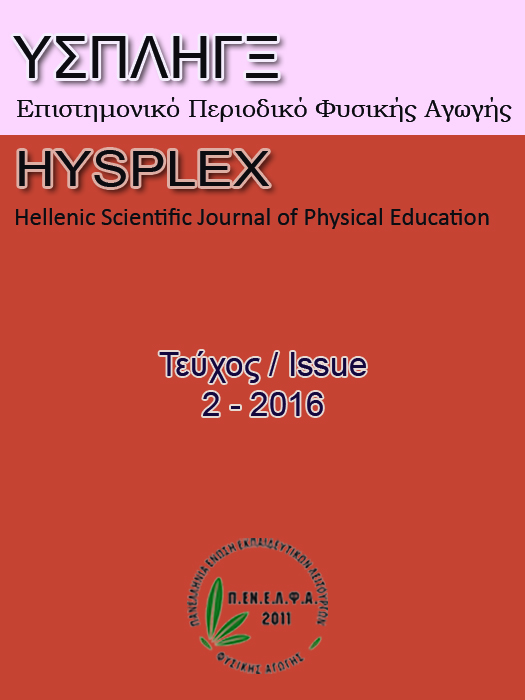Προσαρμογή στα Ελληνικά και στάθμιση τεσσάρων ερωτηματολογίων του διαθεωρητικού μοντέλου σχετικών με τη φυσική δραστηριότητα σε εφήβους

Περίληψη
Mία σειρά τεσσάρων ερωτηματολογίων του διαθεωρητικού μοντέλου προσαρμόστηκαν στα Ελληνικά και σταθμίστηκαν για ένα δείγμα εφήβων. Το πλήθος του δείγματος κυμάνθηκε μεταξύ 17 και 61 εφήβων, στις διάφορες μεθόδους που χρησιμοποιήθηκαν, με μέσο όρο ηλικίας τα 15.8 έτη. Η προσαρμογή έγινε από τα Αγγλικά στα Ελληνικά χρησιμοποιώντας τη μέθοδο μετάφραση-πίσω-μετάφραση. Κατά τη στάθμιση τα ερωτηματολόγια εξετάστηκαν ως προς την ταυτόχρονη εγκυρότητα, εσωτερική αξιοπιστία και αξιοπιστία εξέτασης- επανεξέτασης. Το ερωτηματολόγιο των σταδίων αλλαγής συμπεριφοράς έδειξε ικανοποιητική ταυτόχρονη εγκυρότητα με καρδιοσυχνομέτρηση συνδυασμένη με ημερολόγια δραστηριοτήτων καθώς και ικανοποιητική αξιοπιστία εξέτασης-επανεξέτασης δύο εβδομάδων. Τα ερωτηματολόγια των διαδικασιών αλλαγής συμπεριφοράς, της αυτό- αποτελεσματικότητας και του ισοζυγίου απόφασης βρέθηκαν να έχουν ικανοποιητική εσωτερική αξιοπιστία, και στις περισσότερες περιπτώσεις ικανοποιητική αξιοπιστία εξέτασης-επανεξέτασης δύο εβδομάδων. Καταδεικνύεται ότι τα εξεταζόμενα ερωτηματολόγια φανέρωσαν ικανοποιητικά ψυχομετρικά χαρακτηριστικά ώστε να μπορούν να χρησιμοποιηθούν με εμπιστοσύνη στο παρόν δείγμα αλλά και σε άλλα παρόμοια Ελληνικά δείγματα στο μέλλον.
Λεπτομέρειες άρθρου
- Πώς να δημιουργήσετε Αναφορές
-
Τζωρμπατζάκης Ν., & Sleap, M. (2021). Προσαρμογή στα Ελληνικά και στάθμιση τεσσάρων ερωτηματολογίων του διαθεωρητικού μοντέλου σχετικών με τη φυσική δραστηριότητα σε εφήβους. ΥΣΠΛΗΓΞ: Επιστημονικό Περιοδικό Φυσικής Αγωγής, 2(1). https://doi.org/10.12681/hsjpe.27442
- Ενότητα
- Articles
Οι θεωρητικές και πρακτικές προοπτικές οι οποίες αναπτύσσονται σε κάθε εργασία αποτελούν απόψεις του ίδιου του συγγραφέα και δεν αντανακλούν τις απόψεις της Επιτροπής έκδοσης του περιοδικού.
Με τη υποβολή προς κρίση, ο συγγραφέας καλείται να αποδεχτεί τη Συμφωνία Κατοχύρωσης Πνευματικών Δικαιωμάτων. Με αυτόν τον τρόπο, τόσο ο συγγραφέας όσο και το περιοδικό προστατεύονται από την περίπτωση κατάχρησης υλικού πνευματικής ιδιοκτησίας.
Σημειώνεται ότι οι συγγραφείς είναι υπεύθυνοι να λάβουν την άδεια για χρήση υλικού πνευματικής ιδιοκτησίας από άλλους συγγραφείς στις εργασίες τους.
Οι Συγγραφείς διατηρούν τα Πνευματικά Δικαιώματα και χορηγούν στο περιοδικό το δικαίωμα της πρώτης δημοσίευσης ενώ ταυτόχρονα τα πνευματικά δικαιώματα της εργασίας προστατεύονται σύμφωνα με την Creative Commons Attribution License που επιτρέπει σε τρίτους - αποδέκτες της άδειας να χρησιμοποιούν την εργασία όπως θέλουν με την προϋπόθεση της διατήρησης των διατυπώσεων που προβλέπονται στην άδεια σχετικά με την αναφορά στον αρχικό δημιουργό και την αρχική δημοσίευση σε αυτό το περιοδικό.
Το περιοδικό επιτρέπει και ενθαρρύνει τους Συγγραφείς να καταθέτουν τις εργασίες τους μέσω διαδικτύου (π.χ. σε ένα ακαδημαϊκό καταθετήριο ή στους προσωπικές τους ιστοσελίδες) μετά από τις διαδικασίες της δημοσίευσης, καθώς αυτό μπορεί να οδηγήσει σε παραγωγική ανταλλαγή ιδεών και σκέψεων καθώς επίσης και σε γρηγορότερη και μεγαλύτερη χρήση και ευρετηρίαση της δημοσιευμένης εργασίας (See The Effect of Open Access).


